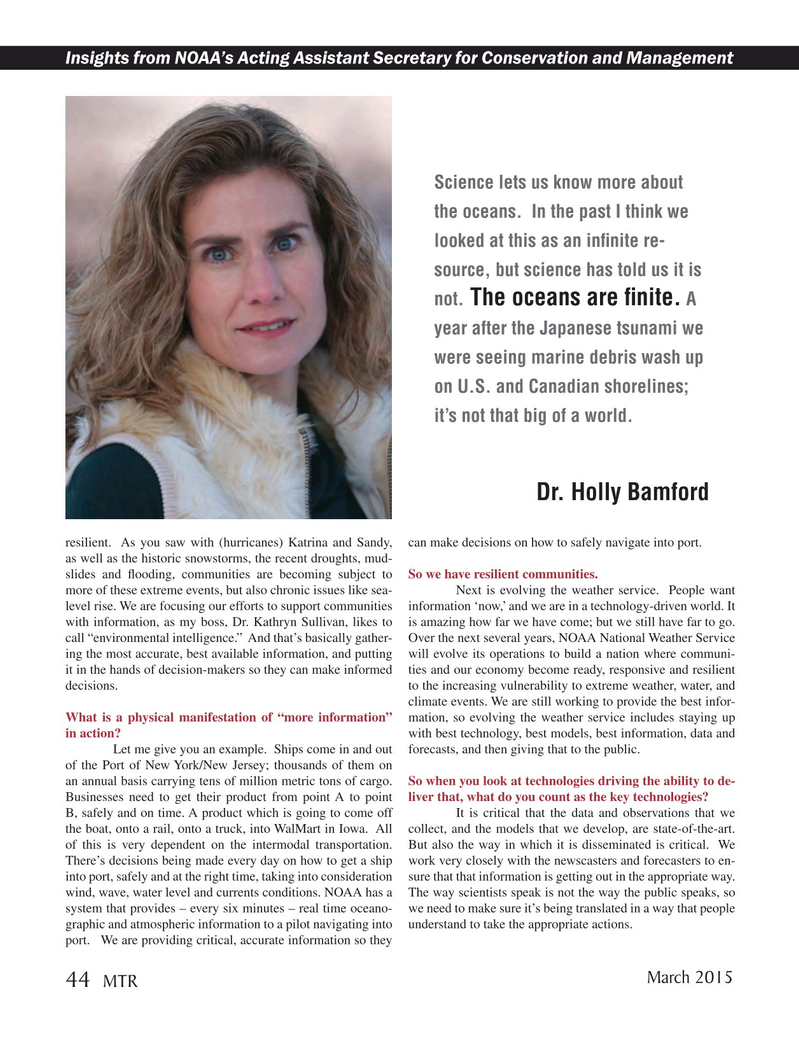
Page 44: of Marine Technology Magazine (March 2015)
Oceanographic Instrumentation: Measurement, Process & Analysis
Read this page in Pdf, Flash or Html5 edition of March 2015 Marine Technology Magazine
Insights from NOAA’s Acting Assistant Secretary for Conservation and Management
Science lets us know more about the oceans. In the past I think we looked at this as an in? nite re- source, but science has told us it is not. A The oceans are ? nite.
year after the Japanese tsunami we were seeing marine debris wash up on U.S. and Canadian shorelines; it’s not that big of a world.
Dr. Holly Bamford resilient. As you saw with (hurricanes) Katrina and Sandy, can make decisions on how to safely navigate into port. as well as the historic snowstorms, the recent droughts, mud- slides and ? ooding, communities are becoming subject to So we have resilient communities.
more of these extreme events, but also chronic issues like sea- Next is evolving the weather service. People want level rise. We are focusing our efforts to support communities information ‘now,’ and we are in a technology-driven world. It with information, as my boss, Dr. Kathryn Sullivan, likes to is amazing how far we have come; but we still have far to go. call “environmental intelligence.” And that’s basically gather- Over the next several years, NOAA National Weather Service ing the most accurate, best available information, and putting will evolve its operations to build a nation where communi- it in the hands of decision-makers so they can make informed ties and our economy become ready, responsive and resilient decisions. to the increasing vulnerability to extreme weather, water, and climate events. We are still working to provide the best infor-
What is a physical manifestation of “more information” mation, so evolving the weather service includes staying up in action? with best technology, best models, best information, data and Let me give you an example. Ships come in and out forecasts, and then giving that to the public. of the Port of New York/New Jersey; thousands of them on an annual basis carrying tens of million metric tons of cargo. So when you look at technologies driving the ability to de-
Businesses need to get their product from point A to point liver that, what do you count as the key technologies?
B, safely and on time. A product which is going to come off It is critical that the data and observations that we the boat, onto a rail, onto a truck, into WalMart in Iowa. All collect, and the models that we develop, are state-of-the-art. of this is very dependent on the intermodal transportation. But also the way in which it is disseminated is critical. We
There’s decisions being made every day on how to get a ship work very closely with the newscasters and forecasters to en- into port, safely and at the right time, taking into consideration sure that that information is getting out in the appropriate way. wind, wave, water level and currents conditions. NOAA has a The way scientists speak is not the way the public speaks, so system that provides – every six minutes – real time oceano- we need to make sure it’s being translated in a way that people graphic and atmospheric information to a pilot navigating into understand to take the appropriate actions. port. We are providing critical, accurate information so they
March 2015
MTR 44
MTR #2 (34-49).indd 44 MTR #2 (34-49).indd 44 3/4/2015 3:41:44 PM3/4/2015 3:41:44 PM

 43
43

 45
45
